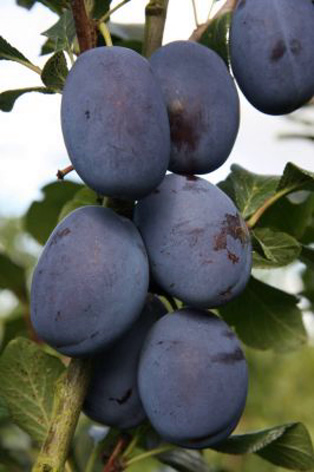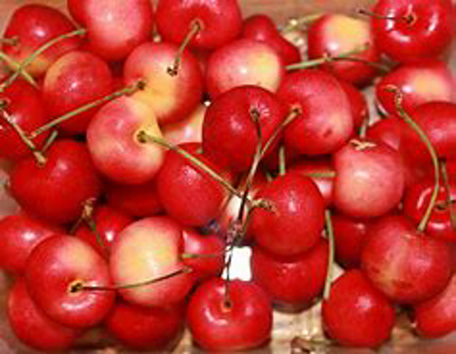

After a quiet couple of weeks when fruit buds sat still, last week's well above average temperatures after the prolonged cold weather has initiated an 'explosion' of blossom on all fruit trees...
The English Apple Man had a busy few days: On Tuesday, attending the Food & Drink Conference organised by Produced in Kent at the University of Kent. Wednesday and off to Pluckley for the BIFGA Spring Walk and Thursday at the Marden Fruit Show (MFS) AGM held at Bradbourne House East Malling. In the afternoon, after the AGM and lunch, we visited the AGRI Trial plot with AGRI Agronomist Colin Bird and his assistant Francesca Salinari.
With so much to report on; this week's Journal will concentrate on the BIFGA Spring walk held at S W HIGHWOOD (PLUCKLEY) LTD. (Winner in association with Mack Multiples of the UK Grower Award Top Fruit/Stone Fruit 2016 awarded by Horticulture Week)
Sheerland Farm is owned by the Highwood family and managed by Charles and James Highwood. Charles manages the production and James takes care of the office and book-keeping........
Below: left; Charles Highwood and right; Haganta Plums
 Our visit to Sheerland was hosted by Charles who told the assembled BIFGA members the farm extended to some 180 hectares with 90 hectares available for fruit. Currently 56 hectares are occupied with Apples; 12 hectares of Plums and Greengage, a 'tiny' (0.3 hectare) of Pears (historically S.W. Highwood grew a considerable area of Comice Pears) and Charles has kept a small area, primarily for family and friends enjoyment.
Our visit to Sheerland was hosted by Charles who told the assembled BIFGA members the farm extended to some 180 hectares with 90 hectares available for fruit. Currently 56 hectares are occupied with Apples; 12 hectares of Plums and Greengage, a 'tiny' (0.3 hectare) of Pears (historically S.W. Highwood grew a considerable area of Comice Pears) and Charles has kept a small area, primarily for family and friends enjoyment.
The Plums are mainly Victoria (Vics) with some Marjorie and Haganta - a German Plum which matures after Marjorie and offers better taste.......Greengage are also part of the 'stone fruit' at Sheerlands: Cherries occupy 12 hectares and on our visit ALL varieties were in full bloom!
Haganta is a dessert plum, similar in appearance to the Marjorie plum with a vibrant blue/purple colour. It has a delicious aromatic flavour that combined with its sweet scent make it very appealing to the customer.
Below: Haganta Plum trees at Sheerlands
The next project will see 4 hectares of Vine grapes planted in 2019 with a similar area in 2020.
Charles has plans for more storage for the apples; the existing block of stores built in his father's day are now ok for cold storage but for longer term marketing new stores with more efficient refrigeration and Controlled Atmosphere (CA) capability are needed. Especially as the Highwood brothers are planning circa 8 hectares of new apple orchards....BUT, new storage will cost in the region of £2,000 a tonne on a new site with concrete base/apron and electricity services provision etc......not really viable with out grant aid.....even amorticed over 20 years, it would add £100 a tonne to the 'cost of fruit' without taking into account annual running costs.......but, hiring storage can now cost £100 a tonne.......so whichever way........it is expensive, so when the consumer looks over the hedge at a nice crop of apples and wonders why they appear expensive on a Supermarket shelf.....believe me they are more than good value for money!
Below: left; Victoria plum trees and right; Victoria plum showing the 'early' formation of fruitlets
Below: Charles Highwood with BIFGA members touring Sheerlands....
As we toured the farm, Charles pointed out various areas of interest: The Jonagold apples grown for Coppella juice; the Victoria plums which appeared to be forming small fruitlets.......and discusion about when to prune etc. Charles prunes the Vics once hecan see the crop potential; with a good fruit set, he knows he has too much fruit on the tree to deliver a viable financial return, so he will prune off all the drooping branches (underneath) removing unwanted fruit. Then when the fruit has made some size and he is confident the frut needs thinning, the plums will be reduced to around 200 per tree, with a target size at harvest of 40mm each. This will equate to 20 tonnes per hectare.
Reaching the cherries, we experienced an unusual sight; ALL the varieties were in full bloom - normally each variety will blossom at a slightly different time; it may be only days, but it will be different, so this was truly unusual. Charles commented; "I hope this does not result in all varieties maturing at the same time too"
Below: Kordia cherries in full bloom
Below: More cherries in bloom
Below: left; Rainier cherries in bloom and right; a 'bouquet of Rainier blossom
Named after Mount Rainier: Rainier is a cross between the 'Bing' and 'Van' cultivars.


The variety Egremont Russet is popular with 'more mature' consumers (The the EAM is one) and since de-listed by some retailers (Sainsbury) Charles has reduced the area at Sheerlands - Jonagold grown for Coppella and not subject to thinning (it is by nature a very heavy cropper) shows some signs of 'blind bud' (no flowers) on trees that 'overcropped last year'
Below: left; Egremont Russet in bloom and right; Jonagold exhibiting 'blind wood'
In last week's Journal The English Apple Man anticipated 'full bloom' occurring next week; e.g. W/C 30th April. Well the explosion of blossom on many varieties has happened this week...........however Cox and Gala will be in full bloom next week. With an abundance of blossom and/if/ the weather allows and we get a good crop of apples this year, pollination will be a key component..........and this brings me to a conversation I had with James Salter an industry friend who in addition to his 'day time' role as an agronomist.........is a passionate bee keeper.
James keeps his own hives and also belongs to a 'bee club' along with other enthusiasts.....James told me the hives are unusually full with worker bees this year 'in sync' with the blossom period.
Below: James Salter impersonating 'a busy bee'
Below: James missive on bee behaviour........
Bees and pollination
To comprehend the complexities within the bee hive we need to look at the breeding pattern in the early part of the year to understand how well they are tuned into the pollination of our English apples at the beginning of the season to produce the crops we grow.
Bees store honey and pollen to see them through the winter. Those stores were collected last summer and autumn and with the shortage of blooms and cold weather in the winter they are reliant upon this food to see them through to the spring and the new flowers. Generally, the queen stops laying in mid to late November and starts again in mid January; during this time the bees cluster together for warmth and consume their stores.
The colony is run on a day length time clock. As the days lengthen the queen starts laying more and more eggs and new bees are born. This is a slow process at first but gains momentum as more bees are produced strengthening the hive.
With a late spring, the colony is unaffected by the cold weather providing there are enough stores to support the new brood being produced. The later the spring, the greater the quantity of flying bees that will be available for the fruit blossom.
With the spring of 2018 being late and then followed by a spell of very favourable weather, the early flowers of cherry, pear and plum were held back but the sunshine brought them on very quickly, and the apples suddenly turned from small green shoots to open blooms. The bee populations have therefore been put in a terrific place to be able to pollinate all the flowers which have appeared simultaneously, due to the quantity of flying bees available at this critical time for fruit production.
The 2018 fruit crop is in a potentially very good starting position........
Returning to the 'explosion of blossom theme' - a few pictures from my garden comparing the blossom movement. The Bladon Pippin has Cox as one parent (hence it has a similar bud development to Cox) and the Discovery is among the first apples to mature in summer - circa late July/August...........
Below: left; Bladon Pippin on 20th April and right; on 27th April
Below: left; Discovery on 20th April and right; Discovery on 27th April
As BIFGA members returned from the 'one hour + tour of Sheerlands, and as we approached the majestic six kiln oast, the rain began to fall......'that's lucky' ............
Below: The magnificent six kiln oast at Sheerlands Farm
Once inside we heard from BIFGA Spring walk event sponsors: Certis and Weatherbys Hamilton.
First up; Semo Kurtev presented news of a Certis product - Amylo-X a broad spectrum preventative Bio-Fungicide.
Semo explained how Amylo-X WG - a natural occurring bacterium is harnessed as a means of preventing disease.
A water dispersible granule containing 250 g/kg Bacillus amyloliquefaciens subsp. plantarum strain D747 for the control of powdery mildew and other fungal plant diseases on a range of crops grown under permanent protection with full enclosure.
Next; Jonny McIrvine and Paul Roberts presented Weatherbys Hamiton's hail insurance package.
Jonny McIrvine and Paul Roberts demonstrated the importance and relative affordability of Hail insurance offered by Weatherbys Hamilton.
Click on: Certis
Click on: Weatherbys Hamilton
Below: Braeburn flowers with the pollen sacs showing pollen has already been released ........
In next week's Journal, The English Apple Man will have more stories and pictures of apple blossom......
Take care
The English Apple Man